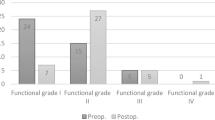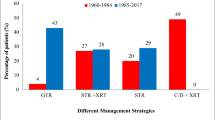Abstract
Object
Craniopharyngiomas (CPs) are histologically benign tumors, yet they may carry an unfavorable prognosis. ”Giant” tumors are associated with worse prognosis. Our aim was to evaluate the impact of tumor’s size on different short- and long-term clinical factors.
Methods
Between 2002 and 2012, a total of 36 consecutive CP patients less than 18 years of age and with at least 12 months of post-operative follow-up (FU) underwent a total of 54 operations for excision of CPs. Gross total resection (GTR) was the goal for all the first surgical resections. Twenty-seven patients were identified as eligible for inclusion in this study. Data were retrospectively collected by reviewing pertinent clinic/office notes and inpatient records as well as pre- and post-operative imaging. Long-term neurosurgical, ophthalmological, and endocrinological outcomes were obtained from records of the most recent FU office visit. Statistical analysis was performed to compare data from patients with tumors greater than or equal to 4.5 cm (nine patients) to those with smaller ones (<4.5 cm; 18 patients).
Results
Mean age at the time of surgery was 5.4 years (median 5 years, range 1.3–15.3 years) for patients in the large-tumor group (LTG) and 8.9 years (median 9.6 years, range 2.1–17.1 years) for the small-tumor group (STG). Average duration of follow-up was 82.1 and 105.4 months for LTG and STG patients, respectively. There was a noticeable difference in the rate of emergent surgeries between the two groups (33.3 vs. 5.5 % in the LTG and STG, respectively; p = 0.055) as well as in recurrent surgeries (RR = 3.76; CI = 95 %, 1.793–7.877) and radiotherapy (RR = 2, 95 % CI 0.775–5.154). Rates of residual tumor on both initial post-operative imaging and last FU imaging were significantly increased in LTG patients (44.5 vs. 27.7 % and 66.6 vs. 16.6 %; respectively). Progression-free survivals (PFS) assessed at 2 and 5 years were 33.3 vs. 73.3 % (RR = 2.2, 95 % CI = 0.171–1.202) and 33.3 vs. 53.3 % (RR = 1.6, 95 % CI 0.221–1.765) in favor of smaller tumors. No difference in 2-, 5-, and 10-year overall survival was found. We found no significant difference in mean BMI at last follow-up between the two groups (23.83 ± 4.86 and 27.33 ± 8.09, respectively; p = 0.27), although significantly more patients in the LTG had shorter stature (mean height SDS −1.72 ± 1.88 and −0.17 ± 1.08 in LTG and STG patients, respectively; p = 0.027).
Conclusion
Tumor’s size has significant impact on the management of CP in children. It affects both short-term factors (initial symptoms, urgency of surgical resection, extent of resection, and perioperative morbidity) as well as long-term parameters (PFS, rate of adjuvant treatments/recurrent surgeries, and metabolic/endocrinal/ophthalmological and functional outcomes). We think that a proper, world-wide accepted definition of what is “large,” “giant,” or even “monstrous” CP should be established. This will enable carrying multi-institutional studies on a larger group of patients, allowing further determining the importance of tumor’s size in the management and outcome of craniopharyngiomas in children.


Similar content being viewed by others
References
Erfurth EM, Holmer H, Fjalldal SB (2013) Mortality and morbidity in adult craniopharyngioma. Pituitary 16:46–55
Karavitaki N, Brufani C, Warner JT, Adams CB, Richards P, Ansorge O, Shine B, Turner HE, Wass JA (2005) Craniopharyngiomas in children and adults: systematic analysis of 121 cases with long-term follow-up. Clin Endocrinol 62:397–409
Hussain I, Eloy JA, Carmel PW, Liu JK (2013) Molecular oncogenesis of craniopharyngioma: current and future strategies for the development of targeted therapies. J Neurosurg 119:106–112
Minamida Y, Mikami T, Hashi K, Houkin K (2005) Surgical management of the recurrence and regrowth of craniopharyngiomas. J Neurosurg 103:224–232
Liubinas SV, Munshey AS, Kaye AH (2011) Management of recurrent craniopharyngioma. J Clin Neurosci 18:451–457
Kalapurakal JA, Goldman S, Hsieh YC, Tomita T, Marymont MH (2003) Clinical outcome in children with craniopharyngioma treated with primary surgery and radiotherapy deferred until relapse. Med Pediatr Oncol 40:214–218
Kim SK, Wang KC, Shin SH, Choe G, Chi JG, Cho BK (2001) Radical excision of pediatric craniopharyngioma: recurrence pattern and prognostic factors. Child’s Nerv Syst 17:531–536, discussion 537
Muller HL, Gebhardt U, Schroder S, Pohl F, Kortmann RD, Faldum A, Zwiener I, Warmuth-Metz M, Pietsch T, Calaminus G, Kolb R, Wiegand C, Sorensen N (2010) Analyses of treatment variables for patients with childhood craniopharyngioma—results of the multicenter prospective trial KRANIOPHARYNGEOM 2000 after three years of follow-up. Horm Res Paediatr 73:175–180
Stripp DC, Maity A, Janss AJ, Belasco JB, Tochner ZA, Goldwein JW, Moshang T, Rorke LB, Phillips PC, Sutton LN, Shu HK (2004) Surgery with or without radiation therapy in the management of craniopharyngiomas in children and young adults. Int J Radiat Oncol Biol Phys 58:714–720
Villani RM, Tomei G, Bello L, Sganzerla E, Ambrosi B, Re T, Giovanelli Barilari M (1997) Long-term results of treatment for craniopharyngioma in children. Child’s Nerv Syst 13:397–405
Zhang YQ, Ma ZY, Wu ZB, Luo SQ, Wang ZC (2008) Radical resection of 202 pediatric craniopharyngiomas with special reference to the surgical approaches and hypothalamic protection. Pediatr Neurosurg 44:435–443
Trejos H, Caceres A, Segura JL (2005) Monstrous craniopharyngioma. Case presentations and term proposal. Child’s Nerv Syst 21:1049–1053, discussion 1054-1045
Fahlbusch R, Hofmann BM (2008) Surgical management of giant craniopharyngiomas. Acta Neurochir (Wien) 150:1213–1226
Elliott RE, Wisoff JH (2010) Surgical management of giant pediatric craniopharyngiomas. J Neurosurg Pediatr 6:403–416
Gupta DK, Ojha BK, Sarkar C, Mahapatra AK, Mehta VS (2006) Recurrence in craniopharyngiomas: analysis of clinical and histological features. J Clin Neurosci 13:438–442
Zuccaro G (2005) Radical resection of craniopharyngioma. Child’s Nerv Syst 21:679–690
Al-Mefty O, Hassounah M, Weaver P, Sakati N, Jinkins JR, Fox JL (1985) Microsurgery for giant craniopharyngiomas in children. Neurosurgery 17:585–595
Yasargil MG, Curcic M, Kis M, Siegenthaler G, Teddy PJ, Roth P (1990) Total removal of craniopharyngiomas. Approaches and long-term results in 144 patients. J Neurosurg 73:3–11
Weiner HL, Wisoff JH, Rosenberg ME, Kupersmith MJ, Cohen H, Zagzag D, Shiminski-Maher T, Flamm ES, Epstein FJ, Miller DC (1994) Craniopharyngiomas: a clinicopathological analysis of factors predictive of recurrence and functional outcome. Neurosurgery 35:1001–1010, discussion 1010-1001
Fahlbusch R, Honegger J, Paulus W, Huk W, Buchfelder M (1999) Surgical treatment of craniopharyngiomas: experience with 168 patients. J Neurosurg 90:237–250
Mortini P, Losa M, Pozzobon G, Barzaghi R, Riva M, Acerno S, Angius D, Weber G, Chiumello G, Giovanelli M (2011) Neurosurgical treatment of craniopharyngioma in adults and children: early and long-term results in a large case series. J Neurosurg 114:1350–1359
Van Effenterre R, Boch AL (2002) Craniopharyngioma in adults and children: a study of 122 surgical cases. J Neurosurg 97:3–11
Yang I, Sughrue ME, Rutkowski MJ, Kaur R, Ivan ME, Aranda D, Barani IJ, Parsa AT (2010) Craniopharyngioma: a comparison of tumor control with various treatment strategies. Neurosurg Focus 28:E5
Elowe-Gruau E, Beltrand J, Brauner R, Pinto G, Samara-Boustani D, Thalassinos C, Busiah K, Laborde K, Boddaert N, Zerah M, Alapetite C, Grill J, Touraine P, Sainte-Rose C, Polak M, Puget S (2013) Childhood craniopharyngioma: hypothalamus-sparing surgery decreases the risk of obesity. J Clin Endocrinol Metab 98:2376–2382
Hoffmann A, Warmth-Metz M, Gebhardt U, Pietsch T, Pohl F, Kortmann RD, Calaminus G, Muller HL (2014) Childhood craniopharyngioma - changes of treatment strategies in the trials KRANIOPHARYNGEOM 2000/2007. Klin Padiatr 226:161–168
Kiehna EN, Merchant TE (2010) Radiation therapy for pediatric craniopharyngioma. Neurosurg Focus 28(4):E10
Merchant TE, Kiehna EN, Kun LE, Mulhern RK, Li C, Xiong X, Boop FA, Sanford RA (2006) Phase II trial of conformal radiation therapy for pediatric patients with craniopharyngioma and correlation of surgical factors and radiation dosimetry with change in cognitive function. J Neurosurg 104:94–102
Merchant TE, Kiehna EN, Sanford RA, Mulhern RK, Thompson SJ, Wilson MW, Lustig RH, Kun LE (2002) Craniopharyngioma: the St. Jude Children’s Research Hospital experience 1984–2001. Int J Radiat Oncol Biol Phys 53:533–542
Klimo P Jr, Venable GT, Boop FA, Merchant TE (2015) Recurrent craniopharyngioma after conformal radiation in children and the burden of treatment. J Neurosurg Pediatr 15:499–505
Simoneau-Roy J, O’Gorman C, Pencharz P, Adeli K, Daneman D, Hamilton J (2010) Insulin sensitivity and secretion in children and adolescents with hypothalamic obesity following treatment for craniopharyngioma. Clin Endocrinol 72:364–370
Darendeliler F, Karagiannis G, Wilton P, Ranke MB, Albertsson-Wikland K, Anthony Price D (2006) Recurrence of brain tumours in patients treated with growth hormone: analysis of KIGS (Pfizer International Growth Database). Acta Paediatr 95:1284–1290
Meacham LR, Sullivan K (2002) Characteristics of growth hormone therapy for pediatric patients with brain tumors in the National Cooperative Growth Study (NCGS) and from a survey of pediatric endocrinologists. J Pediatr Endocrinol Metab 15(Suppl 2):689–696
Price DA, Wilton P, Jonsson P, Albertsson-Wikland K, Chatelain P, Cutfield W, Ranke MB (1998) Efficacy and safety of growth hormone treatment in children with prior craniopharyngioma: an analysis of the Pharmacia and Upjohn International Growth Database (KIGS) from 1988 to 1996. Horm Res 49:91–97
Niu DM, Guo WY, Pan HC, Wong TT (2002) Rapid enlargement of a residual craniopharyngioma during short-term growth hormone replacement. Child’s Nerv Syst 18:164–165
Schoenfeld A, Pekmezci M, Barnes MJ, Tihan T, Gupta N, Lamborn KR, Banerjee A, Mueller S, Chang S, Berger MS, Haas-Kogan D (2012) The superiority of conservative resection and adjuvant radiation for craniopharyngiomas. J Neuro-Oncol 108:133–139
Author information
Authors and Affiliations
Corresponding author
Ethics declarations
Conflict of interest
The authors declare that they have no conflict of interest.
Rights and permissions
About this article
Cite this article
Yosef, L., Ekkehard, K.M. & Shalom, M. Giant craniopharyngiomas in children: short- and long-term implications. Childs Nerv Syst 32, 79–88 (2016). https://doi.org/10.1007/s00381-015-2961-6
Received:
Accepted:
Published:
Issue Date:
DOI: https://doi.org/10.1007/s00381-015-2961-6




